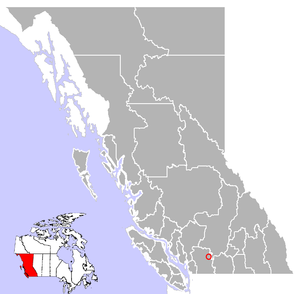
Spuzzum, British Columbia
Encyclopedia

British Columbia
British Columbia is the westernmost of Canada's provinces and is known for its natural beauty, as reflected in its Latin motto, Splendor sine occasu . Its name was chosen by Queen Victoria in 1858...
, Canada
Canada
Canada is a North American country consisting of ten provinces and three territories. Located in the northern part of the continent, it extends from the Atlantic Ocean in the east to the Pacific Ocean in the west, and northward into the Arctic Ocean...
. Because it is on the Trans-Canada Highway
Trans-Canada Highway
The Trans-Canada Highway is a federal-provincial highway system that joins the ten provinces of Canada. It is, along with the Trans-Siberian Highway and Australia's Highway 1, one of the world's longest national highways, with the main route spanning 8,030 km...
, approximately 50 km (31 mi) north of the community of Hope
Hope, British Columbia
Hope is a district municipality located at the confluence of the Fraser and Coquihalla rivers in the province of British Columbia, Canada. Hope is at the eastern end of both the Fraser Valley and the Lower Mainland region, and is at the southern end of the Fraser Canyon...
, it is often referred to as being "beyond Hope". Spuzzum was immortalized in the early 1980s by the band "Six Cylinder" in a song with the refrain "If you haven't been to Spuzzum, you ain't been anywhere."
The name Spuzzum may be a local variant of spatsum, a Chinook Jargon
Chinook Jargon
Chinook Jargon originated as a pidgin trade language of the Pacific Northwest, and spread during the 19th century from the lower Columbia River, first to other areas in modern Oregon and Washington, then British Columbia and as far as Alaska, sometimes taking on characteristics of a creole language...
word for the reed used in basket-weaving. One source claims that the name is an Indian word meaning "little flat", and that Spuzzum was the boundary between the Stó:lō
Stó:lo
The Sto:lo , alternately written as Stó:lō, Stó:lô or Stó:lõ and historically as Staulo or Stahlo, and historically known and commonly referred to in ethnographic literature as the Fraser River Indians or Lower Fraser Salish, are a group of First Nations peoples inhabiting the Fraser Valley of...
and the Nlaka'pamux
Nlaka'pamux
The Nlaka'pamux , commonly called "the Thompson", and also Thompson River Salish, Thompson Salish, Thompson River Indians or Thompson River people) are an indigenous First Nations/Native American people of the Interior Salish language group in southern British Columbia...
peoples.
The town is often used in humorous contexts due to its small size. Until it burned down at the end of the last century, Spuzzum boasted a single gas station and general store, which served as the hamlet's most diverting roadside landmark. As if to sum up its comic status in local cultural life, both sides of a one-time sign on the Trans-Canada Highway
Trans-Canada Highway
The Trans-Canada Highway is a federal-provincial highway system that joins the ten provinces of Canada. It is, along with the Trans-Siberian Highway and Australia's Highway 1, one of the world's longest national highways, with the main route spanning 8,030 km...
read "You are now leaving Spuzzum".
Spuzzum
Spuzzum First Nation
Spuzzum First Nation is a Nlaka'pamux First Nations government located near Spuzzum, British Columbia. It is a member of the Fraser Canyon Indian Administration, one of three tribal councils of the Nlaka'pamux people...
is also the name of the local First Nations government, which is part of the Nlaka'pamux
Nlaka'pamux
The Nlaka'pamux , commonly called "the Thompson", and also Thompson River Salish, Thompson Salish, Thompson River Indians or Thompson River people) are an indigenous First Nations/Native American people of the Interior Salish language group in southern British Columbia...
group. Their offices and community hall and most housing are located between the Canadian Pacific Railway
Canadian Pacific Railway
The Canadian Pacific Railway , formerly also known as CP Rail between 1968 and 1996, is a historic Canadian Class I railway founded in 1881 and now operated by Canadian Pacific Railway Limited, which began operations as legal owner in a corporate restructuring in 2001...
tracks and the Fraser River, just north of where the store/gas station had formerly been.
During the Fraser Canyon War
Fraser Canyon War
The Fraser Canyon War, also known as the Canyon War or the Fraser River War, was an incident between the Nlaka'pamux people and white miners in the newly declared Colony of British Columbia, which later became part of Canada, in 1858. It occurred during the Fraser Canyon Gold Rush, which brought a...
, 3,000 miners from farther up the Canyon gathered at Spuzzum, whose indigenous people were "friendly" and neutral in the conflict, as refuge from attacks by the Nlaka'pamux who lived farther up the canyon.
See also
- Spuzzum First NationSpuzzum First NationSpuzzum First Nation is a Nlaka'pamux First Nations government located near Spuzzum, British Columbia. It is a member of the Fraser Canyon Indian Administration, one of three tribal councils of the Nlaka'pamux people...
- Fraser Canyon Gold RushFraser Canyon Gold RushThe Fraser Canyon Gold Rush, began in 1858 after gold was discovered on the Thompson River in British Columbia at its confluence with the Nicoamen River. This was a few miles upstream from the Thompson's confluence with the Fraser River at present-day Lytton...
- Fraser Canyon WarFraser Canyon WarThe Fraser Canyon War, also known as the Canyon War or the Fraser River War, was an incident between the Nlaka'pamux people and white miners in the newly declared Colony of British Columbia, which later became part of Canada, in 1858. It occurred during the Fraser Canyon Gold Rush, which brought a...
- Alexandra Suspension Bridge

